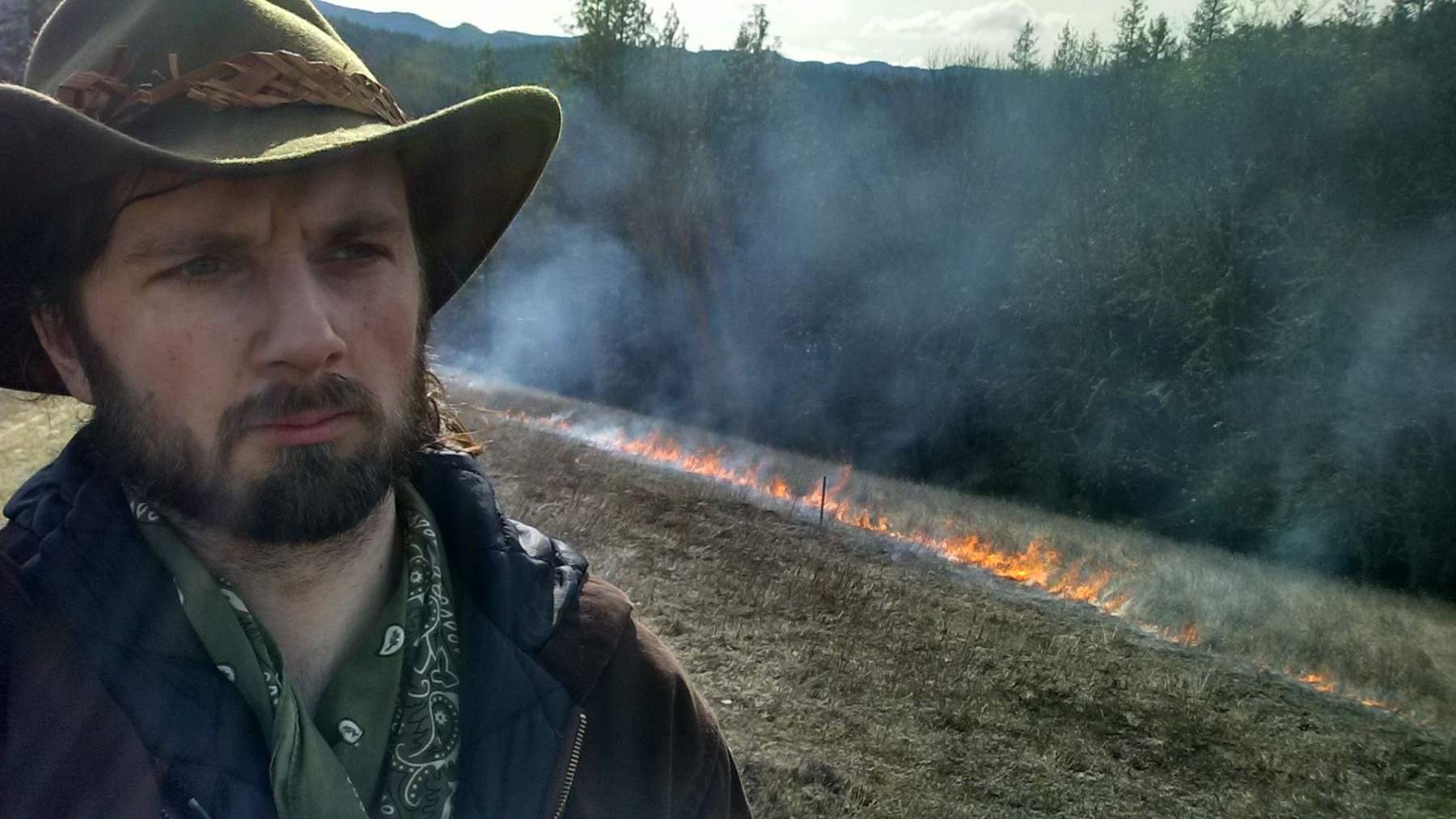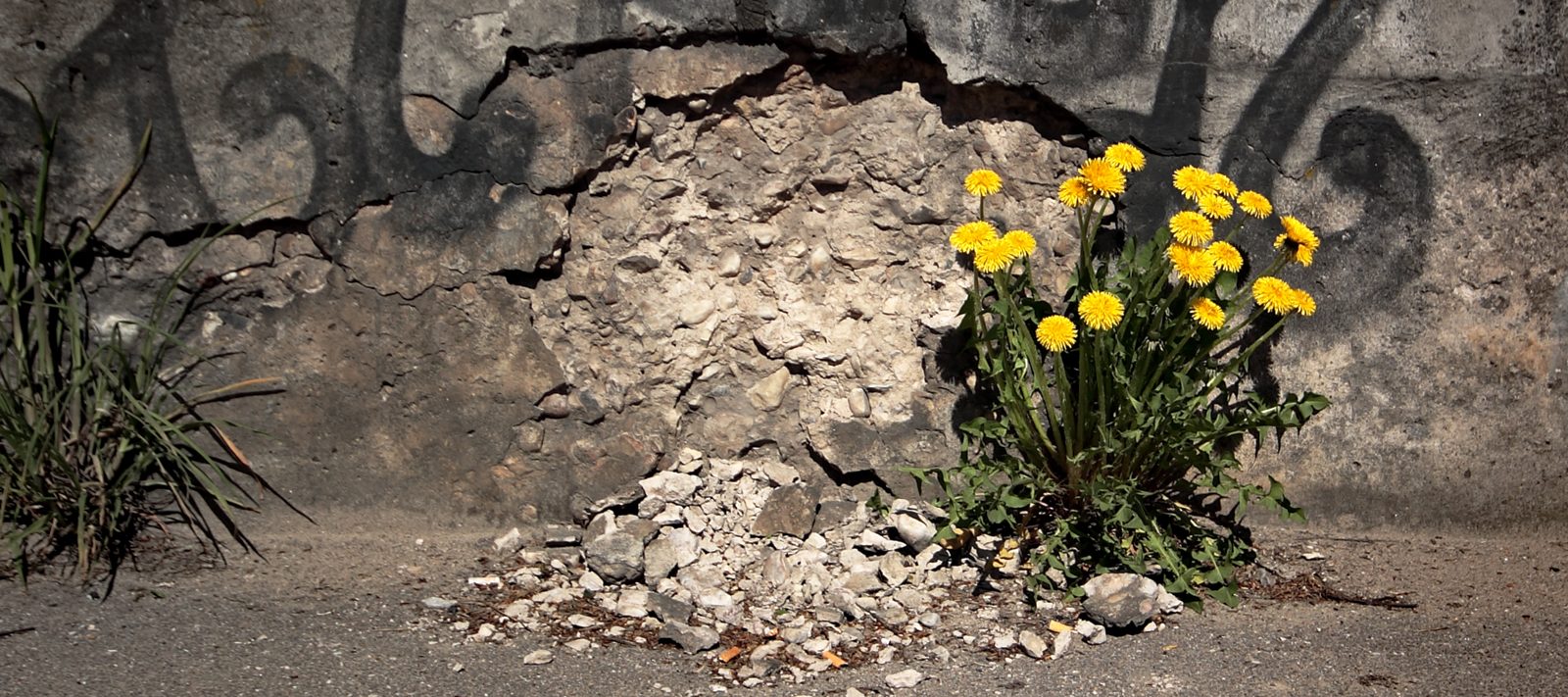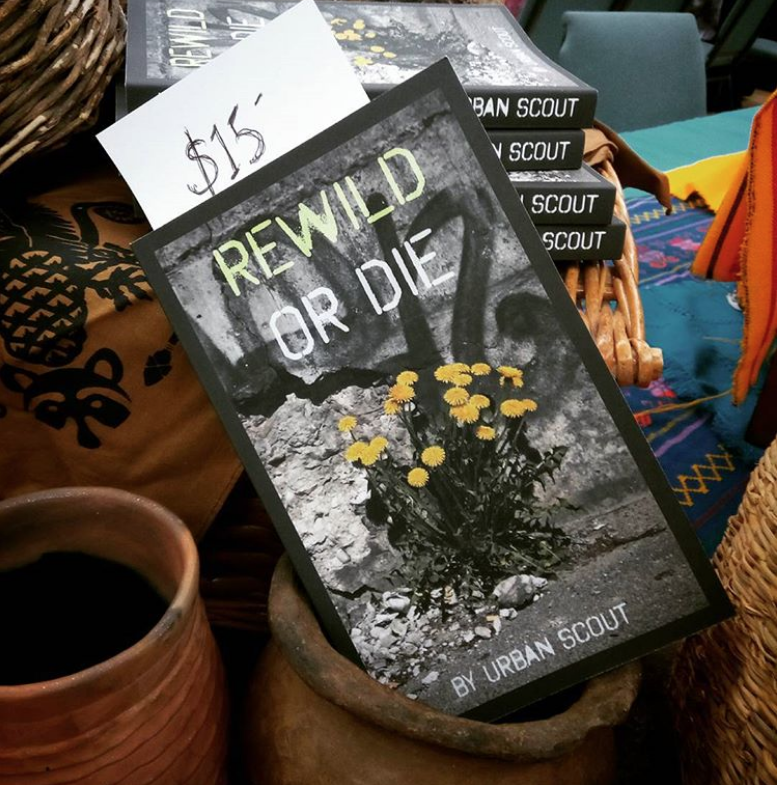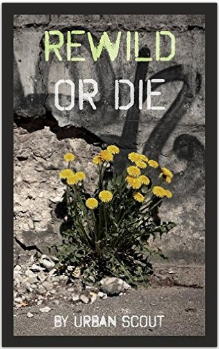I chatted with Scott Mann again, this time about the re-release of my book Rewild or Die. [Listen Here]
 Rewild Portland is a trend-setting organization in the rewilding community. Watch our silly video, learn more about us, and donate.
Rewild Portland is a trend-setting organization in the rewilding community. Watch our silly video, learn more about us, and donate.
Check out this interview/conversation I had with Lian over at the Primal Happiness Podcast!


“Forests are social, they are lonely, and they need us,” proclaimed Hazel, thus beginning a week-long workshop on “social forestry” that involved clearing brush, making charcoal, thinning tree stands, coppicing shrubs, reducing fire danger, weaving baskets, making wooden poles, touring various ecotones, and the main reason most of us were there: prescribed burning. There were lectures on topics including gender, forest systems, holding council meetings, biochar, permaculture forests, “retro-feudalism,” timber stand assessment, transition horticulture, and more. The central theme of the week was a simple yet complex question: “How do we bring back burning to the landscape?” For a wet, dreary week in late January, life couldn’t be more fun for a rewilder!
I’d been curious about using fire to manage the landscape ever since reading M. Kat Anderson’s Tending the Wild back in 2006. The book explains how hunter-gatherers and horticulturalists have used fire to manage landscapes and assist with hunting for thousands (and quite possibly hundreds of thousands) of years. While Tending the Wild focuses on California, books like Indians, Fire, and the Land in the Pacific Northwest, Forgotten Fires, and The Biggest Estate on Earth have given rise to the understanding that land management among hunter-gatherers appears to be more common than previously thought and spans the globe as well as various ecosystems. These studies have blurred the distinctions between hunter-gatherers and horticulturists. Fire has long been a friend of the Homo genus, for warmth, cooking, and security. To what extent, and when we first befriended fire, remains unknown. Many theories link to archaeological hearth sites and physiological changes, but nothing is known for certain. Land management is perhaps one of the most difficult uses to prove.
Social forestry aims to return people to the forest with the practice of strategic burning. Civilization encourages fire suppression. Fire suppression in fire-prone habitats is, to put it bluntly, stupid. What kind of social forestry class would exclude a prescribed burn or two (weather permitting)?
Before burning, you must get the proper burn permits. Once you have permission from the state, you’re ready for site prep. To prep a site you need to establish fire lines, which are essentially barriers to keep the fire from spreading. They are generally wide, flat areas without a fuel source: a paved road, a stream, or a very wide trail with something like the top 6 inches of soil scraped away. Think of it like an invisible fence that contains the fire. We prepped two sites split in half by a gravel road. The lower half ended at a creek; the upper half ended in sparse star thistle and then a thicket of buckbrush. We had water on site, shovels, rakes, and other gear to fight the fire if it got out of hand.
Our goal with these burns was to burn out the seed load of the invasive star thistle, and help germinate the native seeds that are adapted to fire, so that the native plants would have less competition in following years. The first fire was a slow, cold back burn. Starting at the road, we lit the top of the meadow on fire and burned downhill. Imagine lighting a match and holding it upright. It slowly burns down the stick. The meadow slowly burned over the course of 45 minutes, with continuous fires being lit by us to keep it going. It was nice and gentle.
By the time we’d eaten lunch, the morning clouds had drifted on and it was time to try the uphill burn. Imagine lighting a match and holding it diagonally, with the flame rising up from the bottom. It burns hotter and faster, quickly consuming the stick in a large flame. The afternoon sun had come out from behind the clouds and began to dry out the fuel load on the upward slope. The sun also heated the air, causing a pressure change that encouraged the winds to kick up the hill. Then my friend Jesse lit the fire. The next 10 minutes would prove to be the most intense moments of my life in over a decade.
I first met Hazel when I took a Permaculture Design Course with Toby Hemenway in 2009. Back then they went by the name Tom Ward. Hazel is one of those rare humans with an extraordinary breadth and depth of knowledge and a deep, everlasting passion for sharing the information they know and love. They were born and raised a Quaker on the East Coast, from a line of the oldest Quakers in the country. They have a degree in forestry from a highly renowned forestry school, and they’ve taught permaculture with Bill Mollison. Hazel is a botanist, peasant, forester, teacher, and underlying it all, more than a fair bit of a trickster. They stuck out in my class, not just because of their charismatic and unique presence, but because, of all the permaculture experts in that class, Hazel was the only one who seemed to have the vision of rewilding. I remember them saying something along the lines of “the future is bands of nomadic hunter-gatherers wandering the Willamette Valley between permaculture villages.” I remember thinking, oh, here is someone who actually gets it. Beyond getting it, they are creating it, experimenting with it, in their forest laboratory.
Five minutes later, a wall of flame raced across the meadow toward me and the rest of us who stood on the fire line. Another moment later and I couldn’t see much because the flames and smoke had consumed most of my vision. I knew I didn’t really have to worry; I could run to my left where there was no fuel load and I would be okay. But there was one problem. On account of the wind, the flames were so long that they extended over our fire line and jumped it. All of a sudden, shit got real.
I will never look at fire the same way again. It was a sobering moment. Don’t fuck around with fire. Seriously. Stationary fire is not scary. I had never seen fire move before. A friend who had been a firefighter in her younger days told me once about a fire that ripped up an incline she was on, and how she had to jump off a 30-foot cliff to get out of its way. I never quite understood what she meant until now. Firefighters are no joke. Mad respect.

A few weeks after the social forestry class, I had lunch with a friend who had taken it the year before. It was too rainy that year so they didn’t get to burn, and he was eager to hear about this year’s burns. I shared the story of all that happened and he laughed, telling me that he had taken a TREX training once, a government-funded and -operated prescribed-burn education program, where the fire jumped the fire line and burned several acres before they could put it out. Even government professionals can have a hard time containing fire; even with all the safety measures in place, fire can surprise you and do something you didn’t think was possible.
Once we extinguished the fire completely, something unexpected happened. Stunned, adrenaline still coursing through my veins, but the threat gone, I started to cry. Then I started sobbing. I sat down on the hill and just let it out. I was laughing and crying. I just let myself emote. I saw the true, hungry, wild face of a force of nature that I had only ever seen before in captivity. Here, in the forests of southern Oregon, the only thing between the fire and a thick bramble of buckbrush (a plant that contains flammable resin) stood a handful of rewilders with a couple of shovels. The whole experience happened in a matter of minutes. The amount of meadow that took us 45 minutes to burn going downhill took 11 minutes going up.
Later some friends of the farm sent us this picture of our uphill burn seen from a distance:


Back in the lodge, everyone quite frazzled, we sat gathered in a circle. The silence was only to be broken when we felt called to speak. Once everyone felt heard, we would conclude. Aside from the fire itself, the council was one of the most transformative experiences of the social forestry class for me. Partly because it was charged, but mostly because it had the power to diffuse the intensity and collectively debrief the experience without a moderator, without a long list of communication tools.
The reality from my perspective was that the danger wasn’t as bad as we thought. We suppressed the fire in only a few minutes, in part due to the lack of fuel load at the top of the meadow. There was, in a sense, a natural fire line that was better than the one we dug ourselves: about 20 feet of sparse fuel allowed us to simply come in and stamp out the fire once it burned through the heavier load. Hazel, the farm’s forester, was in control of the situation the entire time. I remembered something that I had learned in a mentoring workshop about creating rites of passage. You want the experience to have a “perceived danger high, yet actual danger low.” I think our perceived danger was high and the actual danger very low. However, this led to a very important lesson: fire is no joke. Controlled burns are an important part of ecological restoration, and you must be very careful and have multiple backup plans in place.
We spent the rest of the week doing more mellow but important work. We chopped down trees. We made charcoal. We learned about Hazel’s “retro-feudalism.” (This is a hilarious yet very practical concept put forth by Hazel that I can’t do justice to here, so I won’t try.)
Near the end of the week, in the foggy fir woodland with axe in hand, I realized that this was probably one of the only places where you would find a group of hippies gleefully chopping down trees. That’s part of the magic of social forestry. It reminds me of how I gave up veganism once I realized that I could respect animals and still eat them. You can respect a forest and still chop down trees. (This in no way condones industrial logging or the senseless killing of trees.)
Prescribed burns are no longer a mystery to me. Now I’ve actually done it. It’s not just a theory that I espouse but a skill I have begun to learn through doing. I’ve moved beyond the theoretical stage of fire. Yet this intro class made me realize how much there is to learn in this field. I will probably never become a highly skilled burn boss. It’s not my lot in life. Still, as a spokesperson for the return to these lifeways, it helps to have actually done them. This class was everything I had hoped it would be and more. Perhaps it will be for you too (weather permitting).
Check out Siskiyou Permaculture’s website for upcoming classes on social forestry and more:
Heron’s Social Forestry Video (a different but related program):
Sources:
https://www.firescience.gov/projects/10-1-09-3/project/10-1-09-3_Lightfoot_Cuthrell_Striplen_et_al_2013_proof.pdf
http://news.stanford.edu/news/2010/april/martu-burning-australia-042910.html
http://www.jstor.org/stable/10.1086/681561
Burning questions: evidence for off-site fire use by hunter-gatherers in eHRAF Archaeology
Rewilding starts September 12th. All other dates TBA.
I did this interview with some students from Evergreen for their research last November at the portland plant medicine gathering. I enjoyed it and felt like posting it online. The questions were deep and wide-ranging. It was a really fun interview.
Oregon Live’s Home & Garden section did a write up on my English Ivy basketry project. Check it out here.
People often get on my case for not prescribing a “5 things you can do to rewild” type of program. To me, rewilding is a renaissance; an idea (or cohesion of ideas) that takes form through individual & collective creativity. To make it a program is to kill it. Instead of coming up with a program, I’ve devised this course. Rather than creating a one-size-fits-all Rewilding™, we’ll look at our personal passions, our resources, our social networks, and brainstorm together what is possible for each of us and collectively tackle the barriers that hold us captive to civilization. Who’s ready to roll their sleeves up with me?
Scott Mann at the Permaculture Podcast had me back on the show. This time around we discussed the two realms of rewilding: conservation biology and anarcho-primitivism. There is only so much you can talk about in an hour, but we go pretty deep, only to be left wanting to continue the conversation.












